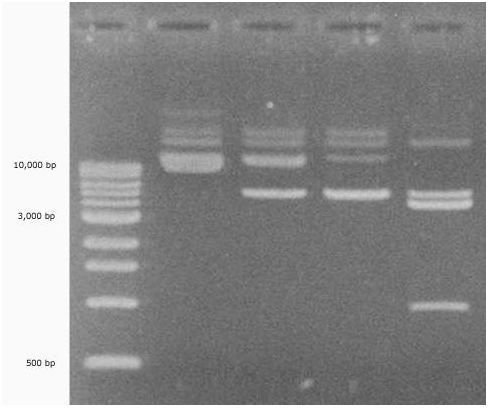The Invention of Electrophoresis
Images
Electrophoresis
Electrophoresis is a highly useful—and often-used—technique for separating proteins, RNA, and DNA, using a gel matrix through which an electric current is applied.
The gel matrix is a cross-linked polymer chosen for a specific composition and weight which depends on the type of molecule under analysis. The gel is a porous but solid matrix, which is placed into a small box. Next, samples of the material under analysis are placed into tiny wells in one end of the gel block. Once the samples have been added, an electric current is applied to the entire gel, and it is then left for several hours.
The term “electrophoresis” refers to the fact that an electromotive force propels molecules through the gel matrix. The distance that a molecule travels in the gel is dependent on its mass and charge.
When the process is complete, the gel can be stained to show the bands of protein or nucleic acid which have been separated by the electromotive force. As shown in the image provided, a single column of multiple horizontal bands represents the contents of one sample, and each band corresponds to a single DNA fragment from the initial sample.
Electrophoresis is used in a wide variety of ways, not all of which are confined to the research laboratory. The technique is used in many scientific disciplines, including biology, biochemistry, genetics, and microbiology, but is also used in forensic work, often in applications involving law enforcement.
Who Invented Electrophoresis?
This highly useful equipment was developed by Oliver Smithies, who is noted not only for this invention, but also because of his discovery, along with Mario Capecchi, of the techniques involved in the creation of knockout mice (a particular type of experimental mouse in which a chosen gene has been inactivated).
Born on June 23, 1925, in West Yorkshire, England, Oliver Smithies credits his lifelong long of science to an early fondness for telescopes and radios. After taking a first class BA in physiology in 1946, he went on to earn a second degree in chemistry, as well as an MA, and a PhD in biochemistry in 1951.
During his long and eventful career, Smithies has worked at the Connaught Medical Research Laboratory at the University of Toronto in Canada (1953-1960), and the University of Wisconsin-Madison (Professor of Genetics and Medical Genetics, 1960-1988). Since 1988, he has been designated an Excellence Professor of Pathology and Laboratory Medicine at the University of North Carolina. Smithies lists his main research interest as the development of animal models of disease. In the past his work has involved cystic fibrosis, and currently includes hypertension and hemoglobin disorders.
For his discovery of the knockout mouse, Smithies was awarded the Nobel Prize in Physiology or Medicine in 2007, alongside Mario Capecchi and Martin Evans.
